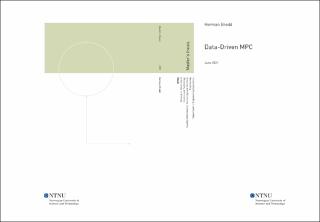| dc.contributor.advisor | Imsland, Lars | |
| dc.contributor.advisor | Godhavn, John-Morten | |
| dc.contributor.advisor | Kittilsen, Pål | |
| dc.contributor.author | Brodd, Herman | |
| dc.date.accessioned | 2021-10-09T17:20:29Z | |
| dc.date.available | 2021-10-09T17:20:29Z | |
| dc.date.issued | 2021 | |
| dc.identifier | no.ntnu:inspera:76427839:27980996 | |
| dc.identifier.uri | https://hdl.handle.net/11250/2788848 | |
| dc.description.abstract | Hovedmålet med denne oppgaven er å implementere en data-drevet metode i Equinors interne programvare for MPC, SEPTIC. Data-drevet kontroll består av direkte bruk av online data fra en prosess underlagt regulering, for å designe regulatoren. I denne oppgaven vil online data brukes til å oppdatere modellforsterkning for stegresponsmodeller, som brukes til å forutsi hvordan en kontrollerbar variabel reagerer på en endring av en manipulert variabel. Modellene i SEPTIC er bygget med ekspermintelle enkelt-pådrag enkel-måling stegresponsmodeller. Stegresponsmodeller antar linearitet. Systemet som den data-drevne metoden er implementert på er imidlertidig svært ulineært. Derfor vil stegresponsmodellene miste nøyaktighet hvis prosessparametrene beveger seg bort fra der modellene ble opprettet. Siden MPC er en modellbasert reguleringsmetode, er en MPC-applikasjon avhengig av å ha en nøyaktig matematisk modell av prosessen den regulerer. Hvis stegresponsmodellene mister nøyaktighet, vil ikke de forutsagte optimale pådragene fra MPCen være optimale. Oppdatering av likevektstilstandsforstekninger for stegresponsmodellene gir vedvarende MPC-ytelse til tross for at de initielle stegresponsmodellene mister nøyaktighet, da identifiserte og oppdaterte modellforsterkninger opprettholder modellkvaliteten. Basert på prosessparametre, vil en automatisk modellforsterkningsidentifikator eksitere prosessen for å identifisere mer presise likevektstilstandsforsterkninger. Korrekte likevektstilstandsforsterkninger vil sikre god MPC-ytelse til tross for at prosessparametrene beveger seg bort fra der de initielle stegresponsmodellene ble opprettet.
Den automatisk modellforsterkningsidentifikatoren vil bli testet på et simulert undervannsbrønnsystem. I et undervannsbrønnsystem er sikkerhet av høyeste betydning. Forhindring av brudd på sikkerhetsgrenser er et generelt mål for en MPC, og anses som avgjørende for undervannsbrønnssystemet i denne oppgaven. Sikkerhetsgrenser legges til i MPC-applikasjonen av sikkerhetsmessige årsaker og anses å være av høyeste prioritet i regulatoren. Når prosessen eksiteres, er det en risiko for brudd av sikkerhetsgrensene. Den automatiske modellforsterkningsidentifikatoren vil eksitere prosessen mens sikkerhetsgrensene blir respektert ved å bruke online data for å redusere risikoen for brudd på sikkerhetsgrensene. | |
| dc.description.abstract | The main objective of this thesis is to implement a data-driven methodology in Equinor's in-house software for MPC, SEPTIC. Data-driven control consists of directly utilizing online data from the process subject to control to design the controller. In this thesis, online data will be used for updating model gains for the step response models, which are used to predict how a controllable variable (CV) responds to a change of a manipulated variable (MV). The models in SEPTIC are built with experimental single-input single-output (SISO) step response models. Step response models assume linearity. However, the system on which the data-driven methodology is implemented is highly nonlinear. Therefore, the step response models will lose their accuracy if the process parameters move away from where the models were created. Since MPC is a model-based method of control, an MPC application depends on having an accurate mathematical model of the process it is controlling. If the step response models lose their accuracy, the predicted optimal inputs from the MPC will not be optimal. Updating the steady-state gains for the step response models yields sustained MPC performance despite the initial models losing their accuracy, as identified and updated model gains maintain model quality. Based on process parameters, an automatic gain identifier will excite the process to identify more precise steady-state gains. Correct steady-state gains will ensure good MPC performance despite the process parameters moving away from where the initial step response models were created.
The automatic gain identifier will be tested on a simulated subsea well system. In a subsea well system, safety is of utmost importance. Preventing constraint violation is a general objective for an MPC and is considered crucial in the subsea well system in this thesis. Constraints are added to the MPC application for safety reasons and are considered the highest priority in the controller. When the process is excited, there is a risk of constraint violation. The automatic gain identifier will excite the process while respecting the constraints by utilizing the online data to reduce the risk of constraint violation. | |
| dc.language | eng | |
| dc.publisher | NTNU | |
| dc.title | Data-driven MPC | |
| dc.type | Master thesis | |
